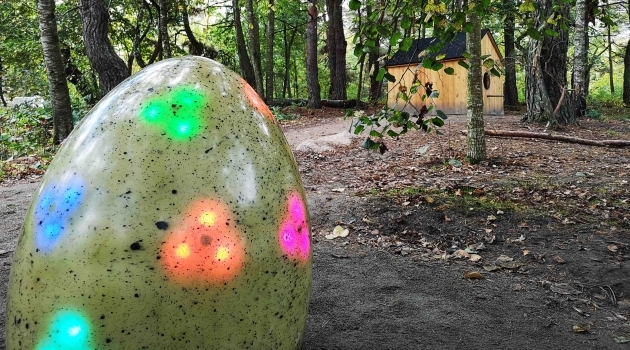The research behind an online playground
In Linköping, children can now play with eggs that are connected to the internet and crawl into a bird’s nesting box where they can hear stories. The unique thing about the playground is that the children, using IoT technology, can influence both the story and the egg. Meet Jon Back, one of the researchers who have developed the playground.
In Magistratsparken in Linköping, children can play in a new technology-augmented playground. There are two large eggs that children can touch and climb on. The eggs are connected to the internet (and each other) and change colours when touched. There is also a small cabin in the form of a bird’s nesting box in the playground where children can listen to different stories based on where they are sitting in the cabin.
Interested in play and games
Jon Back works as an associate senior lecturer at the Department of Informatics and Media at Uppsala University. His background is in design research, and he has spent a lot of time looking at human-computer interaction. He is one of the researchers behind the new interactive playground in Linköping.
– I have always been interested in play and games and in recent years have focused on the way children interact with technology. IoT and play are relatively unexplored areas, which makes this project particularly exciting.
The playground was inaugurated this last spring and is the result of a collaborative project between Linköping municipality, Uppsala University, KTH Royal Institute of Technology and the companies Ecorado and Drakryggen. The project is supported by IoT Sverige with funds from Vinnova, the Swedish Energy Agency and Formas. Jon Back feels that collaborative and outreach projects that bring together academia and the private and the public sectors have great potential for producing exciting results.
A living laboratory
In addition to encouraging children eager to play, the new playground is a testbed for continued research on how children play and interact with technology. It provides a “living laboratory” where Jon can observe how children play, how they move around in the setting and how they integrate with technology and each other. An interesting observation he has already made is that children tend to weave technology into their own games.
– In the bird’s nesting box, for example, children hear stories about different animals and when they leave, we see that they often incorporate these stories into their own games. For children, the boundary between the digital and the physical worlds is not as sharp as for us adults.
Children get to try programming
The technology used in the playground is based on the Internet of Things. Both the eggs and the bird’s nesting box are connected to the internet and have built-in sensors that detect when they are touched. There are also integrated actuators that turn on lights and trigger the start of the stories in the box.
The play installations were programmed in Blockly, a graphical programming language developed specifically for children and youth. The idea is that children will gain a better understanding for technology and gain a sense of inclusion in society.
– Several school classes ages 11–13 have been given the opportunity to reprogram the playground’s online installations. This is a way to create understanding for technology among children and give them the opportunity to be included in and influence their immediate environment.
Do children need more technology?
One question Jon Back is often asked in connection with the new playground in Linköping is why do we need to add more technology to childhood play when they sit in front of screens so much already?
– The simple answer is that the playground in Linköping does not have anything to do with screen time. The technology is used, instead, as a means of getting children to integrate, both with themselves and with the technology, and to also spark interest in nature.
But really, the question is a larger one. Digitisation in society is happening incredibly fast, and technology is not going away. It is more about consciously designing the world we want to have, where people and technology co-exist and can integrate with each other,” concludes Jon Back.
Maria Bergenheim
What’s next for Jon Back
In spring 2022, Jon Back will begin a new project: The ABCs for Meaningful Meetings. In this project, he will develop a model for how physical meeting places can best contribute to increased social interaction and better community as a way of countering alienation. The four-year project is being supported by Vinnova within the framework for the Social Sustainability in the Physical Environment call for proposals and is being conducted as a joint project with Uppsala University, Linnaeus University, the real-estate company Sankt Kors, and the non-profit Gyllene Skräp, which works to disseminate knowledge about sustainable development through experiences and educational tools.

